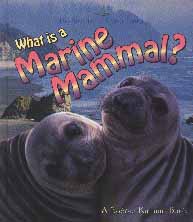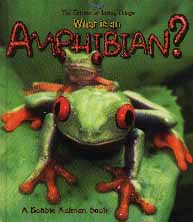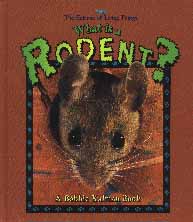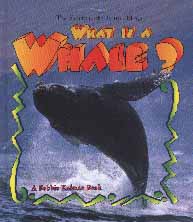|
________________
CM . . . .
Volume VII Number 5 . . . . November 3, 2000
excerpt: What is a marine mammal? 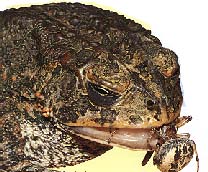 The four books in "The Science of Living Things" series all follow a similar format. Each is
successful in appealing to students in the grade 3 to 6 range and in providing appropriate
information. The books each begin with a definition of the type of animal being examined and
continue through a review of related orders, characteristics, body features, mating and parenting,
food, homes, and relationship to the environment, including human beings. Two page spreads
cover special examples of the mammal or amphibian written up. For example, in What is an
Amphibian?, the featured amphibians included: frogs and toads, salamanders, and caecilians.
Specific information is easily located via the explicit headings in the table of contents and a
glossary is provided. Appropriate scientific terms are introduced in the text which is organized
either into a paragraph with a heading or a box with sentences and the main word italicized.
The four books in "The Science of Living Things" series all follow a similar format. Each is
successful in appealing to students in the grade 3 to 6 range and in providing appropriate
information. The books each begin with a definition of the type of animal being examined and
continue through a review of related orders, characteristics, body features, mating and parenting,
food, homes, and relationship to the environment, including human beings. Two page spreads
cover special examples of the mammal or amphibian written up. For example, in What is an
Amphibian?, the featured amphibians included: frogs and toads, salamanders, and caecilians.
Specific information is easily located via the explicit headings in the table of contents and a
glossary is provided. Appropriate scientific terms are introduced in the text which is organized
either into a paragraph with a heading or a box with sentences and the main word italicized.
Most importantly, in terms of gaining a readership, the books are very attractive. The covers are colourful and, to attract a reader's attention, usually have the face of mammal peering quizzically. Inside, every page has dramatic coloured photos, usually covering half the page. This quartet of books is a welcome addition to any elementary school library looking for overviews of types of animals. Children will select these books for their own recreational reading, and, if the students have broad research topics, then the books will be most helpful. Recommended. Meredith MacKeen is the teacher-librarian at Glen Stewart School in Charlottetown, PEI.
To comment on this title or this review, send mail to cm@umanitoba.ca.
Copyright © the Manitoba Library Association.
Reproduction for personal use is permitted only if this copyright notice
is maintained. Any other reproduction is prohibited without
permission.
Published by
TABLE OF CONTENTS FOR THIS ISSUE - November 3, 2000.
AUTHORS |
TITLES |
MEDIA REVIEWS |
PROFILES |
BACK ISSUES |
SEARCH |
ORDER |
CMARCHIVE |
HOME
|
